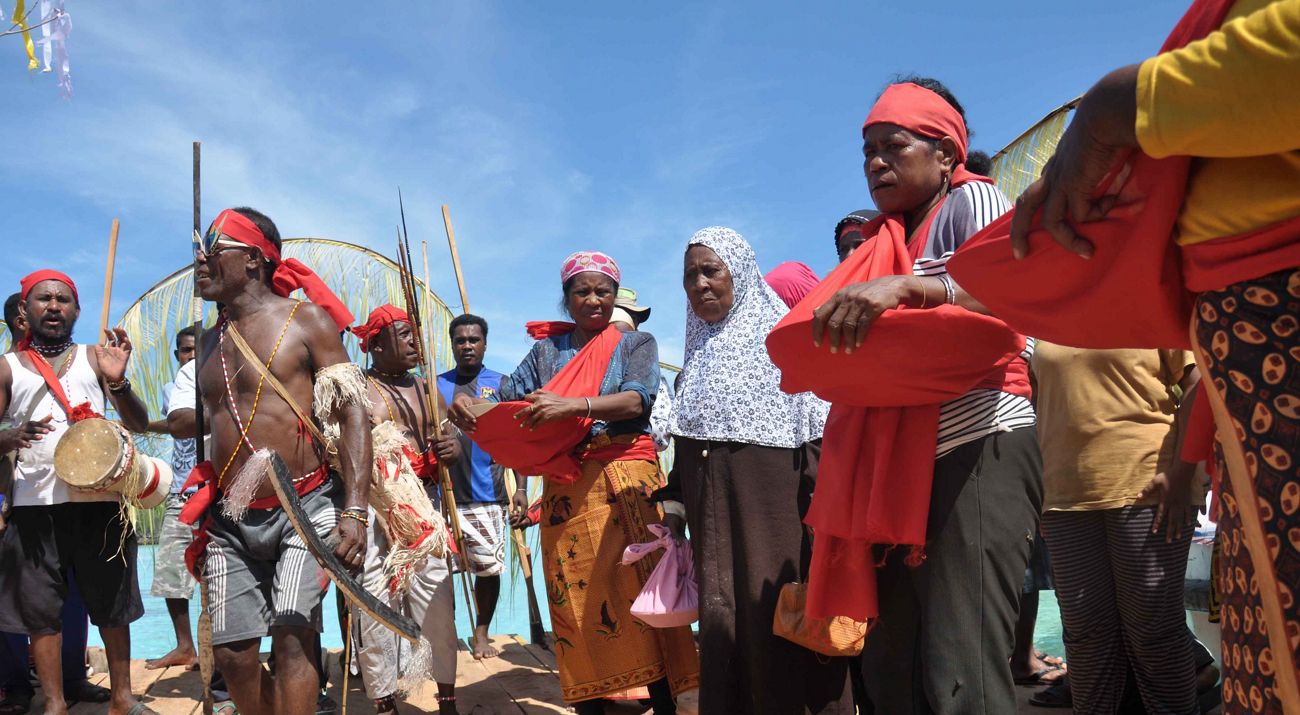The Adat Declaration of Marine Area Management by East Misool District Adat-Law Indigenous Community
Misool, Raja Ampat
The adat-law community in East Misool, Raja Ampat, West Papua, held an ‘Adat’ declaration to begin the management process of the marine area within the Adat-Law community of East Misool on March 12, 2020. This ‘Adat’ declaration embodied the Ministry of Marine Affairs and Fisheries Regulation No. 8 Year 2018 about Procedure to Determine the Management Area of Adat-Law Community in the Spatial Utilization in Coastal Area and Small Islands and conducted to support sustainable natural resources utilization practices. This event was supported by West Papua Provincial Marine Affairs and Fisheries Office, Sorong Coastal Marine Resource Office (Loka PSPL Sorong) of Ministry of Marine Affairs and Fisheries, Raja Ampat Regency Government, and Yayasan Konservasi Alam Nusantara (YKAN).
The marine territories of East Misool adat-law community includes Folley Village, Tomolol Village, West Limalas Village, East Limalas Village, and Audam Village. The marine areas proposed by the communities in the five villages include the traditional fishing area of the East Misool adat-law community covering an area of 72,371.9 hectares, and a fish reservationg zone covering an area of 19,111.4 hectares. The points in adat-law declaration also include an agreement on the sustainable use of natural resources, and the prohibition of the use of fishing gear that is not environmentally friendly such as bombs and potassium.
"This declaration is a momentum for us to continue on maintaining and preserving natural resources, to be enjoyed by our children, grandchildren and generations to come," said Gerardus Moom, a traditional leader from Folley Village.
The Ministry of Marine Affairs and Fisheries Regulation No. 8 Year 2018 explained that the adat-law community is a group of individuals from generation to generation who has been residing in a certain geographic area in Republic Indonesia due to having bonded over ancestral origins, strong relation to the land, region, and natural resources, adat government institution, and adat-law order in the adat region according to the provision of legislation.
"The active participation of indigenous people in protecting coastal and marine resources is very much needed considering the breadth and complexity of marine management issues in West Papua Province which cannot be handled by the government alone," explained the Head of the Marine and Fisheries Service of West Papua Province, Jacobis Ayomi, M.Si.
The native tribe of East Misool District is the Matbat Tribe with six major clans, namely the Moom, Mjam, Mluy, Falon, Faam and Fadimpo clans. The six clans are petuanan/guards who have the rights to manage natural resources at sea and land. One of the examples of sustainable natural resource management practices that they have carried out for generations is the application of the sasi system.
“The initiation of the marine territorial management of East Misool adat-law community is derives back from the history of the use of natural resources applied by the Matbat Tribe ages ago, where nature is a source of livelihood entrusted by God. One of the noble traditions about protecting nature that we still do today is the sasi tradition,” explained Octolius Moom, a traditional leader from Tomolol Village.
Sasi or the practice of managing natural resources by indigenous peoples by closing resources and territories for a certain period of time is still widely known in Eastern Indonesia, particularly in Maluku and Papua. This practice is considered effective, because the level of community compliance is higher than compliance with laws or formal rules. For marine area management, the people of East Misool District, especially in Folley and Tomolol Villages, apply the sea cucumber sasi practices.
Data collected by YKAN from 2013 – 2019 showed an improvement in the quantity of biota and economic benefits since the sasi area was managed well. Within those time frame, during the sasi harvesting period, one household could receive additional incomes of IDR 2,000,000 to IDR 4,000,000 from selling sea cucumbers.
In Indonesia, at least 29 species of sea cucumbers are traded. 11 out of 29 species can be found in the community sasi area facilitated by YKAN. However, because of overexploitation and high market demands, the sea cucumber population in many regions of Indonesia keeps decreasing. In fact, at present, some sea cucumber species are rarely found.
In the early days of establishing sasi (2013) in Folley Village, only 6 species of sea cucumbers were found. However, in 2017 11 types of sea cucumbers were discovered, which is the largest number since 2013. One of the examples of sea cucumbers with high economic value is the Holoturian scabra, with prices ranging from Rp. 600,000 - Rp. . 1.000.000/kg in the local market.
“Ecologically, sea cucumbers have a very important role in maintaining ecosystem health. These roles include neutralizing water pollution (bioremediatory), helping to control ocean acidity, and helping to fertilize the waters. Therefore, a well-managed sasi area provides various contributions, namely improving ecological, social conditions, and community economies," concluded Muhammad Ilman, Yayasan Konservasi Alam Nusantara Director of the Oceans Program.


